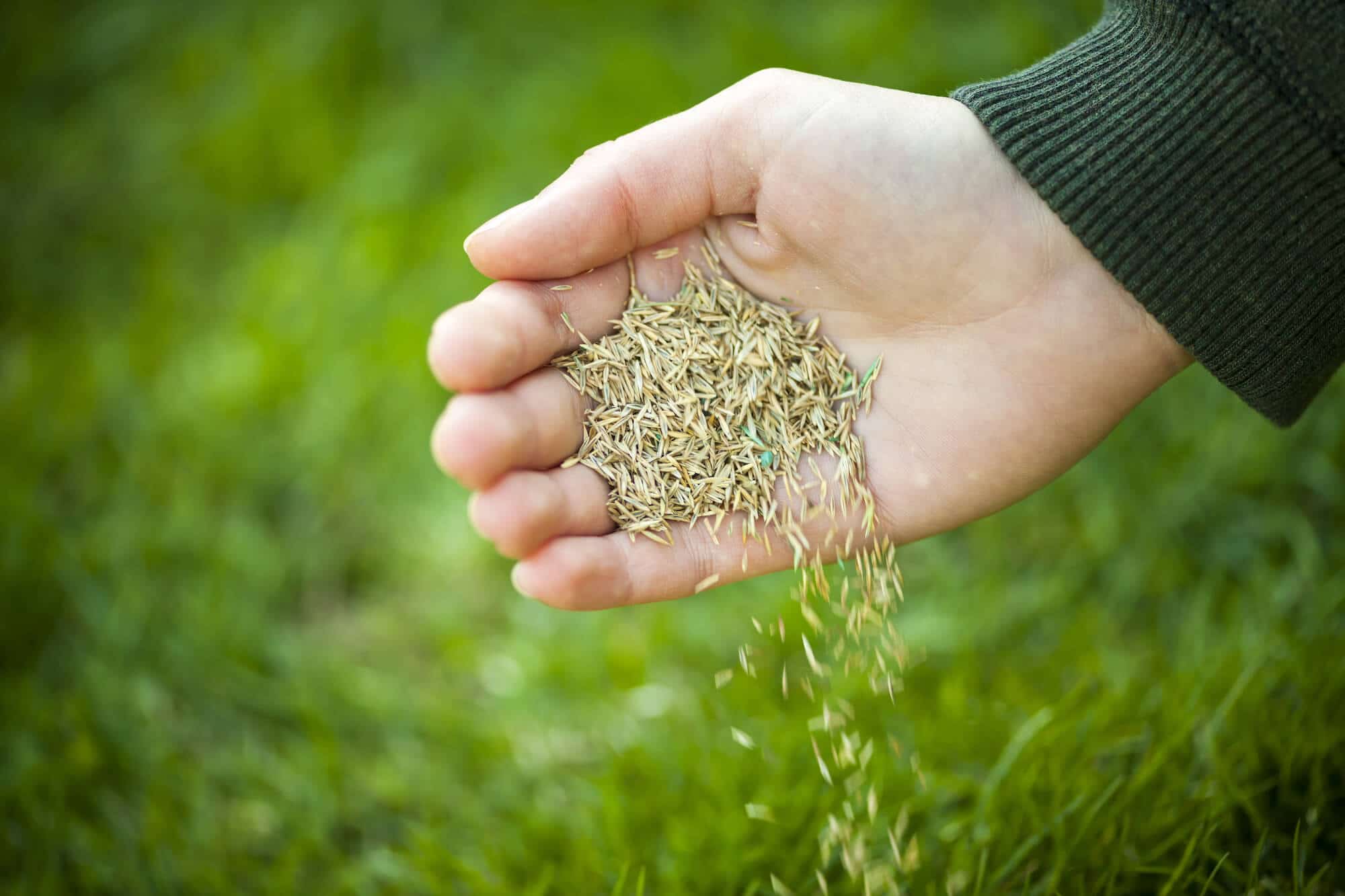How Long Does it Take Grass Seed to Grow?
Planting grass seed for the first time can be confusing and time-consuming, especially if you’re new to lawn care. After you’ve just spent time remedying a major issue with your lawn—or if you’re starting from scratch with new soil—when can you expect a beautiful green lawn ready for everyday use?
Depending on the grass species and environmental factors, grass takes an average of one to four weeks to fully germinate. You will typically start spotting the grass above the ground anywhere between 5 and 7 days. As a general rule of thumb, wait four to eight weeks before returning to your regular maintenance routines.
While several weeks may feel like a long time for these little plants to root into in your soil, there’s no doubt it will be worth the wait. Grass plays an integral role in protecting your lawn from weeds, pests, and erosion, and once it takes root, will stick around for decades when cared for properly.
We’ll break down the quickest-growing seeds, how to find the right type of grass for your area, and how to make informed choices as you start planting.

Fastest and Slowest-Growing Seed Varieties
The germination rate of your grass seeds will have the largest effect on how long you have to wait for that fresh green look in your lawn. Don’t always reach for the quickest species however. While the speedy growers may seem like the best best, not all varieties are right for every region. In fact, most lawns include a combination of two or three grass seed types to ward off disease.
You should also note that grasses are broken into two categories—warm and cool-season grasses. Cool-season grasses thrive in the majority of the country outside of the hot southern states. They will grow best in cooler climates, typically when the soil falls between 50 and 65 degrees. Warm-season grasses, however, like hotter temperatures and take off once the soil reaches between 65 and 75.
| Average Germination for Grass Varieties | ||
| Type of Grass | Warm or Cool-Season Grass | Days to Germination |
| Annual Ryegrass | Cool Season | 5-10 |
| Perennial Ryegrass | Cool Season | 5-10 |
| Tall Fescue | Cool Season | 7-12 |
| Hard Fescue | Cool Season | 7-14 |
| Kentucky Bluegrass | Cool Season | 10-21 |
| Centipede Grass | Warm Season | 14-21 |
| Zoysia Grass | Warm Season | 14-21 |
| Buffalo Grass | Warm Season | 14-30 |
As you can tell, warm-season grasses need a bit more time to germinate than cooler ones, so it’s best to schedule more time for care if you plan to plant these varieties.
What Affects Seed Growth?
Just like all plants, a seed needs balanced environmental conditions to take off without interruption. After you toss seeds onto your lawn, its hull will break open after it absorbs proper nutrients and reaches the right levels of hydration and heat to thrive.
The right environment for proper seed growth will balance:
- Water
- Nutrients
- Temperature
- Oxygen
The first few days after breaking open are crucial to its health—and vast changes in moisture or temperature can slow down or stop its growth. Significant wind or too much water can also wash the seeds away.
Here are the top factors that will affect if and how quickly your grass seeds take root.
Planting Season
As we mentioned above, the planting season has a lot to do with the speed of your grass seed growth. Both warm and cool-season seeds should be planted when the soil reaches its ideal temperature.
Take note that the temperature of the air does not always reflect the temperature of your soil. Purchase a soil thermometer at your local hardware store and measure about three inches into the ground before overseeding or planting new turf.
Planting Cool-Season Grasses
Cool-season grass seeds are best spread either in the time between summer and fall—preferably around early September—or in early spring at least two weeks after the last frost. The summer/fall transition is ideal because the soil will reach that prime range between 50 and 65 degrees.
Don’t wait too long to plant the seeds in the fall, however, since they need enough time to germinate before the first frost. If you’re in doubt, err on the side of caution and plant in August.
Planting Warm-Season Grasses
Grass that thrives in the hotter climates does best when spread just before the peak of the summer. Plant warm-season grasses in late spring or early summer to give them the best chance to thrive during their peak season.
Soil Quality
Another large factor in the speed of germination depends on the makeup of your soil. In an ideal situation, your yard will maintain what is known as loam soil. Loam soil offers a balance of clay, silt, and sand. It both holds moisture and allows it to drain to avoid disease and compaction. The balance of these three parts will vary based on where you’re located in the US.
Your soil should also reach the ideal pH for growth, preferably between 5.8 and 7.2. Landscape professionals can test your pH or you can purchase an at-home pH soil test online. Adding lime or sulfur to adjust its levels.
In the best-case scenario, your soil has room for air, nutrients, and sunlight to permeate beyond the present turf. In some cases, it can be helpful to aerate or dethatch your soil before starting.
Watering Schedule
Without question, watering before and after spreading grass seeds has one of the largest effects on its growth. Before the seed goes out in your seed spreader, the ground should maintain a balance of moisture without being sopping wet. Your water schedule after growth—which we’ll go into a bit more below—is crucial for keeping your young seeds happy.
Other Environmental Factors
The health and layout of your lawn will also play a large part in your grass health. For example, different seeds are best for either shaded or sunny areas. Some are more resistant to disease than others while some varieties can even ward off pests.
It’s also important to think about how much foot traffic your yard receives. Growing new seeds in soil after heavy use requires more attention than grass that rarely goes disturbed.
How to Spread Grass Seed
Prepping and spreading grass seed properly will ensure that it grows at a healthy pace. Whether you’re planting a whole new lawn by hand or fixing small damaged areas, it’s important to time planting with the ideal growing conditions.
Here is how to prepare your lawn for seeding and what to expect once the seeds are in the ground.
Prepare Your Soil
As we outlined above, soil conditions greatly affect the rate of germination. Before planting seeds, ensure your turf and soil meet the following conditions:
- The soil and turf are properly fertilized with a mixture ideal for your new seed variety.
- The soil maintains a pH between 5.8 and 7.2.
- For existing lawn, ensure your thatch layer measures less than half an inch thick.
- Your soil is properly aerated.
- The ground is moist down to one six to eight inches below the earth, but is not soaking wet.
Choose the Right Seed
Speak with a landscaping professional about the right type of seed for your lawn, whether you’re starting from scratch or bulking up your lawn with overseeding.
Some experts will recommend choosing hearty grass blends such as ryegrass and Kentucky bluegrass or by adding a fescue to tolerate extreme temperatures. Your lawn activity, sunlight level, climate, and local pests should all contribute to choosing the right blend.
Spread Evenly
If you choose to spread grass seed yourself, you can purchase a grass seed spreader at your landscape provider or online. The manual spreader can send both seed and fertilizer out into your lawn by simply filling the top bin with your desired mixture.
Begin on the outside of your lawn and evenly distribute the seed, walking steadily yet carefully not to cover the same areas twice. Weave up and down the length of your yard, avoiding any hardscape features.
Monitor Your Water
Water your soil the day before to reach several inches below the ground to get that balance ideal for growth.
Once your seed covers the earth, your watering schedule will kick into high gear. For the first several days, water lightly twice a day to ensure the ground remains moist but does not lead to pools or streams of water that can shift the seeds around.
Cut this schedule down to once a day, and eventually once every other day, until your grass reaches the height to be mowed.
Let it Rest
In the first six-to-eight weeks after you spread the grass seed, mark off your lawn to keep people and animals from treading on the newly planted areas. The seeds will not need to be mowed, and typically cannot handle mowing, for several weeks as well.
Protect it From Future Threats
As your grass begins to grow, keep an eye out for persistent weeds trying to take up space where your seeds are trying to root.
Most grass blend containers will also recommend waiting to spray herbicide or pesticides on new lawns until several weeks after they complete the germination period. Until then, delicately pull weeds by hand, making sure to remove the rooms and not to disturb the surrounding soil.
Overseed Regularly
After your seeds have successfully taken root, look ahead to the next overseeding season. This is particularly important if you’re growing a new lawn from bare soil. It may take several overseeding passes to get that dense and lush lawn strong enough to keep out weeds and protect against drought, erosion, and pests.
Professional Lawn Care and Seed Planting
Ensuring your grass seed grows correctly can take some trial and error. By working with a professional landscape team, cut down on the time it takes to learn what makes grass seed grow and thrive properly.
TruGreen offers year-round plans to both enhance and maintain a stunning lawn no matter where you live in the country. The team can help you determine the best seed choice, how to amend your soil, and care for the lengthy maintenance after the seeds hit the soil.
If you have questions about how to grow grass seed from scratch—or would like a free estimate from a caring and highly trained company—contact your local TruGreen team for a complimentary consultation.







